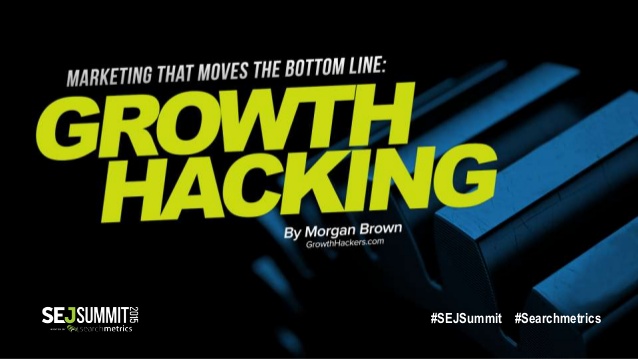Morgan Brown was the last speaker at the SEJ Summit in Santa Monica last week and he covered one of the buzziest topics in the industry, growth hacking. Brown has 15 years experience growing startup companies, wrote Startup Growth Engines with Sean Elis, and studies fast growing companies in his down time, so growth hacking is his new specialty. He continued to stress the fact that most businesses don’t fail at making a product; they just fail at gaining customers and growing the business.
What is Growth Hacking: According to David Heinemeier Hansen, growth hacking is a cool-sounding euphemism for making the doer feel good about using the same old sleazy marketing tricks. This was the introduction to Brown’s presentation and what it means to use a growth hacking playbook for success.
Using a Growth Hacking Playbook
When using a growth hacking playbook you have to do three things: Experiment with all available growth levers, understand what’s driving growth and then test to improve it, put a heavy focus on product and optimization.
Brown also made mention that growth hacking isn’t only for consumer-focused companies like Dropbox or some of the other growth hacking successes like AirBnB, PayPal, and even Twitter. B2B companies such as LinkedIn and HubSpot have found success with growth hacking as well. HubSpot, for example, offers a free tool called the HubSpot Marketing Grader. This tool didn’t need any traditional marketing because it offer the tool for free and created something that audiences want to know. It’s easy and it’s on their homepage. Below is an example of the Marketing Grader tool:
Putting Growth Hacking to Work for Your Business
The first part of putting growth hacking to work for your business is finding your own growth levers and exploring to make it happen. You want to work on discovering the “why” in order to lead to breakthroughs in growth.
For example, AirBnB (one of the most successful growth hacking stories out there) discovered that the listings with high-quality photos received 2-3X more bookings than other bookings. They then decided to invest in professional photography and their booking activity exploded and desire increased. This is the perfect example of no marketing really needed—they just needed to explore their data and understand their audience’s patterns. Below is the screenshot Brown used in the presentation that shows this growth:
Again, it’s all about knowing the metric that you’re trying to improve and then identifying influencing behaviors (this could be logins, downloads, adding a user, etc.). You have to be willing to experiment when it comes to growth hacking by balancing high impact and high probability tests.
3 Takeaways on Growth Hacking from Brown
There are three main takeaways to remember when it comes to growth hacking:
- Growth hacking complements marketing—it’s not a replacement.
- Use data to find leverage points and double down on those points.
- Rapid, continuous experimentation key to growth—no silver bullets.
Brow also recommends using a few tools to help you be successful. First, analytics: Identify drop-off points and under-performing pages (Google Analytics, KISSMetrics). Second, Qualitative Insights: Uncover the why behind the numbers (Qualaroo, SurveyMonkey). Third, A/B Test: Find better performing combinations to drive conversion rate (Optimizely, Unbounce).
To check out Brown’s entire presentation, visit the Search Engine Journal Slideshare.net account here. I also highly recommend checking out this article we wrote on growth hacking last month that gets into a few more specific examples and different definitions of growth hacking.
What are your thoughts on growth hacking? Have you tried this type of marketing and found success? Let us know in the comment section below.


